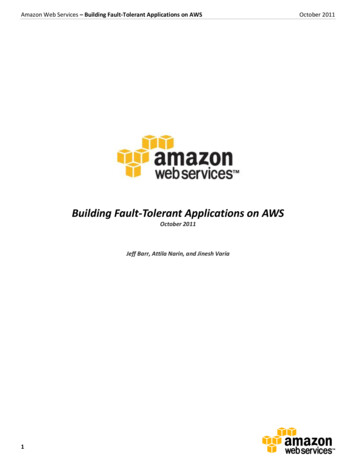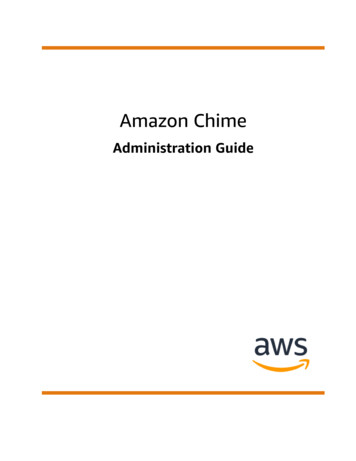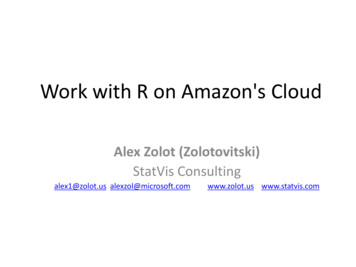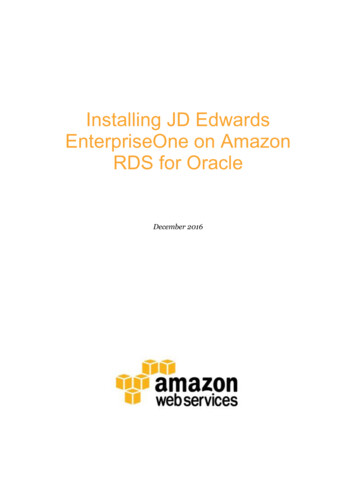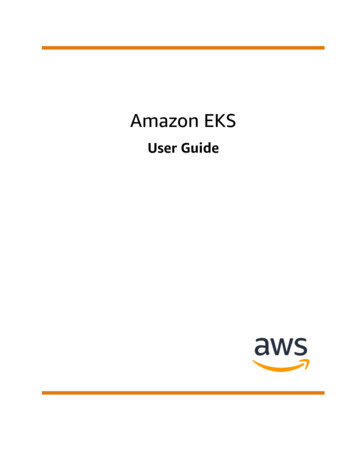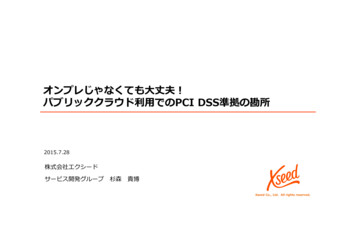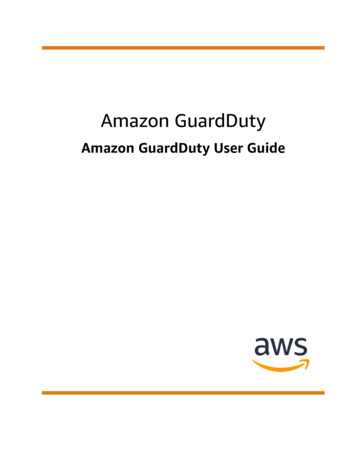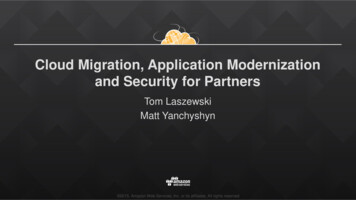
Transcription
Cuba Ransomware Groupon a Roll herePublishedApril 2021Copyright2021Page 1
1.1Executive SummaryAt the end of 2020, our team, made up of SecurityJoes and Profero incident responders, ledan investigation into a complex attack in which hundreds of machines were encrypted,knocking the victim company offline completely. The threat actors behind the attack deployedthe Cuba ransomware across the corporate network, using a mixture of PowerShell scripts,SystemBC, and Cobalt Strike to propagate it. Cuba Ransomware utilizes the symmetricChaCha20 algorithm for encrypting files, and the asymmetric RSA algorithm for encryptingkey information. As a result, the files could not be decrypted without the threat actor'sprivate RSA key.In the days following the attack, our incident responders investigated the modus operandi ofthe threat actors, their malicious software and lateral movement tools. Simultaneously, weinitiated negotiations with the attackers, who over the course of the investigation, wediscovered are Russian speakers, due to a simple translation mistake on their part.Unfortunately, due to several essential missing links, we were unable to approximate theattackers’ location, and as a result, their whereabouts remain unknown. Negotiationsconcluded with the ransom being paid, and with the successful receipt of a decryptor. Afterwe determined the decryptor contained no malicious code within, and confirmed that it did infact decrypt the encrypted files, we deployed it across the network, allowing operations toresume.The discovered ransomware binary was generic. It utilized implemented algorithms forencryption and stored strings in plaintext—however, it was wrapped with several layers ofobfuscation and packers.Based on these factors, we believe the attackers are not state-sponsored, instead operatingsimply as a threat group. They are fast acting, and seem to prefer to communicate viaemail—they generally launch their attacks by setting up email accounts to initiatecommunication a few days in advance of deploying ransomware. Additionally, based onransom notes we’ve discovered through pivoting, it’s clear the actors often use ProtonMailas their primary email host.Copyright2021Page 2
1.2Technical Details1.2.1OverviewWhile Cuba Ransomware has purportedly been active for a few years, they’ve only recentlygained notoriety, primarily for publishing leaked documents from infected companies thatresisted their blackmail attempts. One of their more recent targets was the Automatic FundsTransfer Services, whose stolen data was listed on the actor’s .onion site and is thought tocontain sensitive information such as bank employee correspondence, balance sheets, taxdocuments, and other financial documents.For the attack we investigated, the threat actors used a variety of tools to propagate throughthe network, before landing on two servers they engaged as main distribution points. Theyused PSEXEC to distribute the Cuba Ransomware binary, which led to the encryption of alarge number of network machines.Upon execution, Cuba begins to encrypt all files on the infected machine, dropping itsransom note to each directory under the name “!!FAQ for Decryption!!.txt”. Unlike otherransomware families, the ransom note does not include a key for identification—it is moresophisticated, indicating this threat group likely performs a low volume of attacks againsthigh-value organizations. The Cuba note informs the victim that all their files are encrypted,and invites them to contact the group via email to send payment in exchange for adecryptor.Dropped Ransomware NoteBased on our experience with these threat actors, we can confirm they do indeed provide avalid decryptor upon payment. However, because we are unable to determine whetherpaying victims get retargeted, we recommend that the ransom should not be paid.Copyright2021Page 3
1.2.2Infection ChainDuring our investigation, we discovered a batch file that had been dropped onto a coresystem, together with two PowerShell scripts. Interestingly, one of the PowerShell scripts andthe batch file were named based on the last octet of the C2 server they reached out to (forexample 182.ps1 and 182.bat if the C2 is 185.153.196.182). After collaborating with McAfeeATR during their investigation of Cuba Ransomware, we confirmed that this was, in fact, acampaign identifier, rather than a coincidence. The second PowerShell script was aptlynamed socks1.ps1 and involved execution of SystemBC.The deployed batch file was utilized for disabling the EDR/AV on the infected system, aswell as altering the permissions of network shares to be accessible by everyone, and addinga firewall rule to allow RDP connections over port 3389. Finally, the batch script created anew user with a legitimate name, based on a service in the environment, then added thisuser to the Administrators and Remote Desktop Users group, before deleting itself. One ofthe PowerShell scripts executed a Cobalt Strike stager, to reach out and download the mainCobalt Strike implant, and the other, as mentioned, set up the SystemBC proxy on thesystem, loading it into memory using shellcode:PowerShell Script used to execute SystemBC binaryCopyright2021Page 4
SystemBC related strings found in binarySystemBC is a notorious proxy1 malware that can route connections through SOCKS5 in anattempt to hide communications between an implant and its C2 server. In the past, thistechnique has been used by the group operating Ryuk.2 It is commonly dropped alongsideCobalt Strike beacons to shield the traffic from detection, especially when threat actorsinteract with it frequently, in attempts to pivot across the network. Generally, whenSystemBC is deployed, the attack revolves around ransomware infections,3 although it hasbeen distributed alongside banking trojans such as Danabot.In this case, the SystemBC payload was deployed to communicate with a hardcoded IPaddress over port 5050. We were surprised to locate multiple SystemBC samples allcommunicating to the same IP address, some with the default network packet marker“xordata”, and some with custom markers.Copyright2021Page 5
Hardcoded IP seen in SystemBC binary after configuration decryptionDuring the investigation process, we discovered that a prior infection with TrickBot hadoccurred, raising the question whether it had served as the delivery method for Cuba.However, after consulting with leading security researchers, we believe it to be highlyunlikely that TrickBot dropped Cuba ransomware onto the machine, as it is primarily knownto drop Ryuk4 and Conti ransomware. We also completed an investigation internally, andfound no evidence to support such a theory. We suspect the ransomware was most likelydropped through the usage of SystemBC and Cobalt Strike on the infected machines.Copyright2021Page 6
1.2.3Ransomware Algorithm AnalysisLike most ransomware families, there is nothing remarkable about Cuba ransomware. Thetwo main encryption algorithms used are ChaCha20 and RSA. Both are implemented in thesample, rather than utilizing the WinCrypt library for encryption. As with most variants ofransomware, the symmetric algorithm is used for encrypting the file, while the asymmetricalgorithm is used for encrypting the symmetric key.Image of key blob inside Cuba-encrypted fileCuba ransomware is also referred to as Fidel ransomware,5 due to the marker placed at thebeginning of all encrypted files. The marker is part of a 1024-byte header, prepended to allencrypted files. The file marker itself is used as an indicator to the ransomware (and thedecryption tool), that the file has been encrypted. The rest of the header contains a largechunk of data containing essential information required to decrypt the file. However, the datais encrypted using RSA, and therefore cannot be decrypted without the use of the attackers’RSA private key. This allows operators behind Cuba ransomware to generate completelyrandom encryption keys for each file—and to still be able to decrypt them even afterpayment has been received.As with several other ransomware families that implement encryption algorithms rather thanusing the Windows Cryptography API, Cuba ransomware utilizes the RSA functions offeredCopyright2021Page 7
by the wolfSSL6 library. We were able to identify that the actors used an open-sourcelibrary, when an extremely useful indicator emerged in the form of non-modified returnvalues.Snippet of pseudocode inside Cuba: wolfSSL linked functionBased on these return values, and the presence of Windows Cryptography API forgenerating random data, we were able to link the algorithm to wolfSSL’s implementation ofRSA. Additionally, rather than providing a specific private key in the decryptor, the attackersused a block of data as a seed in a random number generation (RNG) function. This seed,in turn, generates the private key, used to decrypt the data blob stored in the file. Thedecrypted blob contains 44 bytes of important data: a 32-byte ChaCha20 key, and a 12-byteIV.Comparison of decompiled code in Cuba to wolfSSL source codeThe ChaCha20 algorithm in use was also taken from an open-source implementation.However, the attackers altered certain parts of the code, such as modifying return valuesCopyright2021Page 8
and joining the ChaCha20 key and IV initialization together. As a result, attribution is morecomplicated in comparison to the RSA code, however, it is still very likely to have originatedfrom the wolfSSL library.Comparison of decompiled ChaCha20 code in Cuba to wolfSSL source code1.3Threat Actor InformationThroughout our research, we found links to victims who shared valuable information that ledus to believe that the group comprises Russian-speaking individuals. The first major hint wasCopyright2021Page 9
an incorrect translation: The word “north” appeared in a message regarding exfiltrated filesand encrypted servers—a context in which it seemed out of place. Investigating further, welearned the Russian words for “server” and “north” are very similar. It seems to us extremelylikely the attackers made a typo in the original Russian text prior to translation.Translation of “north” to RussianAfter the negotiations were finalized, we focused our efforts on the webpage supposedly setup by the actors behind Cuba. The site was hosted on the Tor network and lists severalcompanies who refused to cooperate and pay the ransom—as well as the stolen data, mostof which is up for sale. Combing through the website, we confirmed our suspicion that theactors spoke Russian: we came across a custom 404 error page in Russian, roughly stating,“Oh, this is 404! blablabla 404 blablabla.”Screenshot from the Russian 404 error page1.4Copyright2021Payment TrackingPage 10
Once the ransom payment was finalized, we broadened our investigation to include tracingthe flow of Bitcoin in an attempt to gather additional intelligence on the threat actors. As theimage below—which was captured using the CipherTrace platform—shows, the threat actorsfollow a highly complex transaction procedure to avoid tracking attempts. It includes usingcoin mixers, third-party exchange services, and several different wallet providers, all togetherindicating the threat actors possess a sound understanding of anonymizing transactions.Analysis of the payment mixing usedWe have compiled a list of services the threat actors were utilizing to evade tracking, andbelow are summaries of the purposes of a selection of them.CoinToCard: http://cointocard.org/Binance: https://www.binance.com/enChangeNow: https://changenow.io/MorphToken: https://www.morphtoken.com/Huobi: https://www.huobi.com/en-us/Wasabi: https://wasabiwallet.io/Copyright2021Page 11
ChangeNow websiteChangeNow allows for swift, anonymized exchanges between cryptocurrencies, such asBTCàXMR, LTCàETH, and even same-coin exchanges such as BTCàBTC. All that isrequired to perform these changes is an input address and an output address. From there,it is as simple as transferring an amount over to ChangeNow and receiving it in the outputwallet. This transaction occurs through the ChangeNow platform, and as a result, furthertracking would require knowledge of the receiving address. We do not believe the threatactors immediately cashed out after receiving funds from ChangeNow into the new wallet.Instead, they likely passed the transfer through a similar obfuscated transaction flow before itreached a final destination.Copyright2021Page 12
MorphToken websiteMorphToken is a very similar service to ChangeNow, allowing a user to transfercryptocurrency from one blockchain to another. The usage of both testifies to thesophistication of either the services the threat actors employ to obfuscate transactions, or oftheir own personal actions.Huobi and Binance are both extremely large global exchange networks. These networksallow seamless transfers between different cryptocurrencies, and as a result could helpfacilitate further obfuscation of the attackers’ transfers. It is possible that in the case ofHuobi, the transfers are sent not directly to a Huobi-linked account, but to wallets hosted bythe platform, which are then dispersed to smaller exchanges such as ChangeNow andMorphToken.During our analysis of the transactions, we discovered a small number of transfers that tookplace utilising the Wasabi Wallet technology, potentially to increase the anonymity of thetransfers. These significantly differed from the majority of transfers we discovered in ouranalysis, potentially suggesting an additional third-party service was used for a certainnumber of coins.After gaining an understanding of the complex pathways that the threat actors took in orderto anonymize the bitcoin transfers, we can confidently assume that they are highlyaccustomed to managing large transfers, further indicating they have extensive experiencewith sizable ransom payments.Copyright2021Page 13
1.5VictimsWhile the Cuba Ransomware group has been around for some time, it only established itselfas a major player recently, when the attackers breached the Automatic Funds TransferService and hosted stolen files on their Tor site, which they then made accessible to others,for a fee. Prior to that, they targeted several companies in wide-ranging sectors, including alogistics company, a real estate firm, and an aviation company. Based on the irregularpattern and the sophisticated nature of their attacks, it is difficult to ascertain whether thereare motives beyond financials in the group’s targeting process.Over the course of our investigation, we discovered multiple uploads of the ransom note toVirusTotal, each with different contact addresses. Considering these emails together, wegained a picture of when the attacks occurred, as the email addresses are generallyregistered a day or two before deploying the ransomware. It seems the attackers attempt tomaintain an authentic image by following through with promises on not releasing data andproviding a decryptor—however it is impossible to know, at least at this point—whether theydelete it on their back-end, or leave it accessible for use in the future.Copyright2021Page 14
1.6References1. kits2. new-ryuk-ransomware-attack/3. ors-using-systembc-malware-asbackdoor-a-156124. https://us-cert.cisa.gov/ncas/alerts/aa20-302a5. https://twitter.com/siri urz/status/1327233462617731074?s 206. ht2021Page 15
two main encryption algorithms used are ChaCha20 and RSA. Both are implemented in the sample, rather than utilizing the WinCrypt library for encryption. As with most variants of ransomware, the symmetric algorithm is used for encrypting the file, while the asymmetric algorithm is used for encrypting the symmetric key.

![Index [beckassets.blob.core.windows ]](/img/66/30639857-1119689333-14.jpg)
